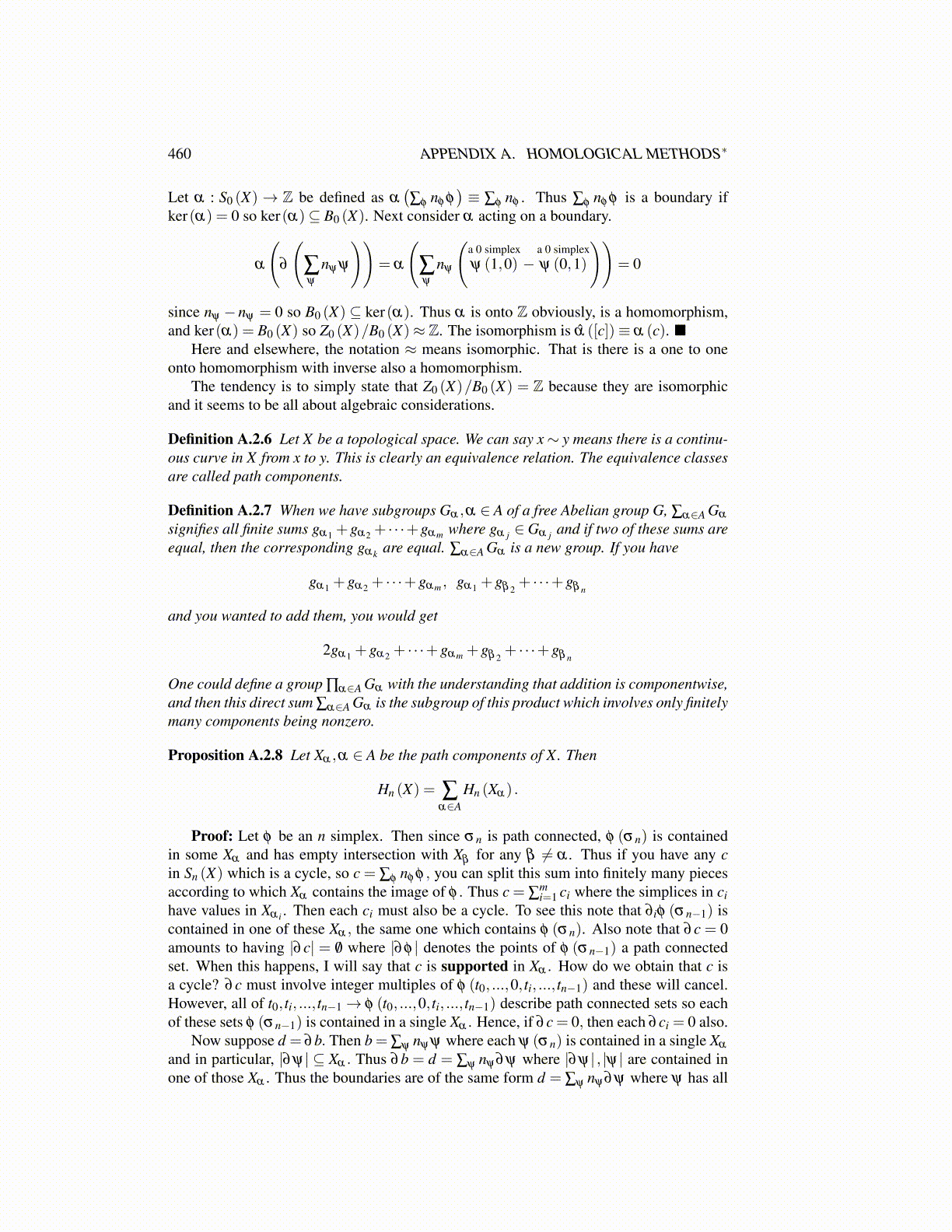
460 APPENDIX A. HOMOLOGICAL METHODS∗
Let α : S0 (X)→ Z be defined as α(∑φ nφ φ
)≡ ∑φ nφ . Thus ∑φ nφ φ is a boundary if
ker(α) = 0 so ker(α)⊆ B0 (X). Next consider α acting on a boundary.
α
(∂
(∑ψ
nψ ψ
))= α
(∑ψ
nψ
(a 0 simplexψ (1,0) −
a 0 simplexψ (0,1)
))= 0
since nψ −nψ = 0 so B0 (X) ⊆ ker(α). Thus α is onto Z obviously, is a homomorphism,and ker(α) = B0 (X) so Z0 (X)/B0 (X)≈ Z. The isomorphism is α̂ ([c])≡ α (c). ■
Here and elsewhere, the notation ≈ means isomorphic. That is there is a one to oneonto homomorphism with inverse also a homomorphism.
The tendency is to simply state that Z0 (X)/B0 (X) = Z because they are isomorphicand it seems to be all about algebraic considerations.
Definition A.2.6 Let X be a topological space. We can say x∼ y means there is a continu-ous curve in X from x to y. This is clearly an equivalence relation. The equivalence classesare called path components.
Definition A.2.7 When we have subgroups Gα ,α ∈ A of a free Abelian group G, ∑α∈A Gα
signifies all finite sums gα1 +gα2 + · · ·+gαm where gα j ∈Gα j and if two of these sums areequal, then the corresponding gαk are equal. ∑α∈A Gα is a new group. If you have
gα1 +gα2 + · · ·+gαm , gα1 +gβ 2+ · · ·+gβ n
and you wanted to add them, you would get
2gα1 +gα2 + · · ·+gαm +gβ 2+ · · ·+gβ n
One could define a group ∏α∈A Gα with the understanding that addition is componentwise,and then this direct sum ∑α∈A Gα is the subgroup of this product which involves only finitelymany components being nonzero.
Proposition A.2.8 Let Xα ,α ∈ A be the path components of X. Then
Hn (X) = ∑α∈A
Hn (Xα) .
Proof: Let φ be an n simplex. Then since σn is path connected, φ (σn) is containedin some Xα and has empty intersection with Xβ for any β ̸= α . Thus if you have any cin Sn (X) which is a cycle, so c = ∑φ nφ φ , you can split this sum into finitely many piecesaccording to which Xα contains the image of φ . Thus c = ∑
mi=1 ci where the simplices in ci
have values in Xα i . Then each ci must also be a cycle. To see this note that ∂iφ (σn−1) iscontained in one of these Xα , the same one which contains φ (σn). Also note that ∂c = 0amounts to having |∂c| = /0 where |∂φ | denotes the points of φ (σn−1) a path connectedset. When this happens, I will say that c is supported in Xα . How do we obtain that c isa cycle? ∂c must involve integer multiples of φ (t0, ...,0, ti, ..., tn−1) and these will cancel.However, all of t0, ti, ..., tn−1→ φ (t0, ...,0, ti, ..., tn−1) describe path connected sets so eachof these sets φ (σn−1) is contained in a single Xα . Hence, if ∂c = 0, then each ∂ci = 0 also.
Now suppose d = ∂b. Then b = ∑ψ nψ ψ where each ψ (σn) is contained in a single Xα
and in particular, |∂ψ| ⊆ Xα . Thus ∂b = d = ∑ψ nψ ∂ψ where |∂ψ| , |ψ| are contained inone of those Xα . Thus the boundaries are of the same form d = ∑ψ nψ ∂ψ where ψ has all